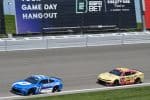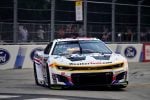Did You Notice? … The $1 Million NASCAR In-Season Challenge has been all bark and no bite? The hype surrounding this idea and its implementation has fizzled as all the heavy favorites got knocked out.
What we’re left with, after starting with 32 drivers, are eight wheelmen who have yet to win a NASCAR Cup Series race all season. Only two, Alex Bowman and Tyler Reddick, have ever visited Cup victory lane in their career. In their place sit drivers like Ty Dillon and John Hunter Nemechek, a duo that’s combined to post just three top-five finishes in well over 350 Cup starts.
Those results have left a tournament hoping to bring a little charisma to the summer dangerously close to the cutting room floor. It’s an idea that had the best of intentions: We should be careful, when criticizing the outcome, not to rag on Denny Hamlin’s creativity that brought us here. We need more of it — drivers, teams, and executives thinking outside the box to keep NASCAR relevant year-round. In 2025, a world driven by attention you disappear if you’re not out there trying to get any.
Hamlin’s in-season idea was a fresh take, a NCAA-tournament like knockout pool where two drivers go head-to-head each race. Whomever wins advances to the next round, a 32-driver tournament where the one person standing after the Brickyard 400 later this month walks away with $1 million.
The NBA has had success with its in-season tournament, giving hope to NASCAR that it’d find a similar boost. But the rules over there were far different; for starters, there are four games of pool play determining which teams make the final cut. That made it less likely the eight teams who advanced would all be the worst in the league (or close to it).
NASCAR’s model tried to use this type of pool play, utilizing a driver’s best finish over a three-race stretch to seed the field. But doing that led to confusion, not clarity. No one could quite understand how a driver like Ty Gibbs, for example, was a six seed despite spending a lion’s share of the season outside the top 20 in points.
The rules also knocked out the one full-time driver, Shane van Gisbergen, who has spent the summer moonlighting as a sudden championship contender. He’s won two out of the last four races but was knocked out of the initial process by not being in the top 32 in points before seeding began.
Confused? Yeah, you’re not the only one. A sport that already has problems explaining to a new or more casual fan things like the point system, the playoffs and stage racing now has to sit there and justify why a two-time winner during the tournament process was never even part of the field.
It’s not that the idea itself is bad. Head-to-head battles are what the sports bettors are laying money on in the NASCAR space these days. It’s a group filled with young millennials and Gen Z fans the sport has tried to snatch up, eager to follow these races within a race on their DraftKings-like platforms each weekend.
But when you’re talking about a special in-season bonus, I think bigger. NASCAR’s original Winston Million contest, in place from 1985 to 1997, gave a $1 million bonus to a driver who won three of the sport’s four crown jewel races: the Daytona 500, the Winston 500 at Talladega Superspeedway, the Coca-Cola 600 at Charlotte Motor Speedway and Darlington Raceway’s Southern 500.
In the 13 years of that initial program, only two drivers won it — Jeff Gordon and Bill Elliott — which made it that much more special. The drama leading up to those races drew additional attention to the sport, sometimes during a year where the championship was all but decided (back in those days, there were no playoffs). Here, watch for yourself.
Even in the years no one won, there were plenty of times the Southern 500 featured a driver with a shot at $1 million. And these were people worthy of the prize; earning a chance meant two wins, minimum, at two of the sport’s toughest racetracks.
You don’t have the same type of quality performances here. In theory, a driver could advance through all five rounds simply by beating the driver they’re paired with: a 29th over a 30th, a 30th over a 35th and so on each week could hand them $1 million. It’s luck of the draw, excitement for bettors but hardly something that gets you a Hall of Fame bullet point on the resume.
There’s also no real competition bonus for the in-season tournament winner beyond the $1 million prize. No extra playoff points, no guaranteed spot in the postseason. It lessens the importance for the drivers running out front every week, most of whom are making seven-figure salaries at this point anyway.
Can the In-Season Tournament be salvaged? If Dillon (the 32 seed) winds up an unlikely champion, probably not. But a few tweaks to the idea could wind up producing a better outcome.
Here’s how I would fix the tournament.
- Cut down to 16 drivers, not 32. Too much to follow over the course of one race, especially in the beginning rounds.
- Make the rules similar to the postseason: Seed the field by playoff points (winners only) and allow a winless regular-season points leader (if there happens to be one) a spot as well. This way, people have a better shot at understanding the seeding process; they see a similar type of format play out every September.
- For the remaining spots in the field, fill them over a three-race stint via the drivers with the best average finish. And make all drivers eligible; don’t cap at 32 in a year where you have 33 or more full-time competitors.
- Then, when you start your tournament, keep it head-to-head with the smaller group. And when you get to the finals, give the winner a 15-point playoff bonus (we give the same for the regular-season champion) along with an automatic bid into the postseason field.
The rules would still be a little complex but would eliminate two of the problems with this tournament. It cleans up the underdog mess at the bottom of the field (while still ensuring their participation) and also gives the best drivers incentives to fight their way through head-to-head combat.
Let’s hope, no matter how the rest of this tournament turns out, NASCAR will revisit the rules come 2026. And just because this idea went bad doesn’t mean creativity should stop. Part of throwing things at the wall to see what sticks involves throwing things that don’t stick.
The act of throwing is what’s important, especially in this era of sports. We’ll see if NASCAR stays willing to rise to that challenge.
Did You Notice? … Quick hits before taking off …
- Right along those same lines we just talked about comes news Dodge may consider a reality show, a competition that gives someone an opportunity to drive one of its Rams next year in the NASCAR Craftsman Truck Series. What a great idea. Exactly the type of energy I was hoping Dodge could bring to the table.
- In just one month, van Gisbergen has racked up the fifth-most playoff points of anyone in the Cup Series. With Sonoma Raceway this weekend and Watkins Glen International next month, there’s an outside chance he could catch Kyle Larson’s 23 for tops overall. That’s enough of a cushion you need to consider him a serious contender for playoff advancement even with only one road course, the Charlotte Motor Speedway ROVAL, sitting in the 10-race playoffs.
Follow Tom Bowles on X at @NASCARBowles
The author of Did You Notice? (Wednesdays) Tom spends his time overseeing Frontstretch’s 40+ staff members as its majority owner and Editor-in-Chief. Based outside Philadelphia, Bowles is a two-time Emmy winner in NASCAR television and has worked in racing production with FOX, TNT, and ESPN while appearing on-air for SIRIUS XM Radio and FOX Sports 1's former show, the Crowd Goes Wild. He most recently consulted with SRX Racing, helping manage cutting-edge technology and graphics that appeared on their CBS broadcasts during 2021 and 2022.
You can find Tom’s writing here, at CBSSports.com and Athlonsports.com, where he’s been an editorial consultant for the annual racing magazine for 15 years.





